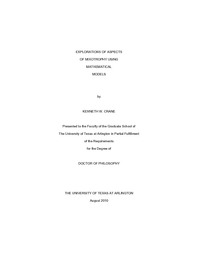| dc.description.abstract | This work examined three theoretical aspects of mixotrophy, the simultaneous use of phototrophic and heterotrophic nutritional modes, and one practical application. The first study addressed the coexistence of microorganisms pursuing diverse nutritional strategies. It was found that in the range of model environments explored that all four types of organisms were predicted to persist for certain parameter combinations. The most successful mixotrophs were predicted to be primarily autotrophic, supplementing photosynthesis with bacterivory. The second study extended the first one by focusing on the effects of environmental parameters governing resource supplies and the responses of populations and ecosystem properties in relation to relative supplies of light and phosphorus. The model generally predicts that mixotrophs are abundant under wide ranges of resource supplies and leave a signature on the properties of aquatic ecosystems, such as phosphorus recycling. The third study further extends the model by incorporating seasonal variations in physiology. The densities of organisms and their growth limitations in response to this seasonal forcing were analyzed, along with the ecosystem properties of phosphorus flux and the C:P ratios of the organisms. The predictions of this seasonal model suggest that mixotrophs change the growth limitations of other organisms, and increase the recycled P flux in the microbial food web. The final study examined the consequences of adding mixotrophy to a model for Prymnesium parvum, a harmful algal species that forms blooms in Texas in the winter. This modified model was unable to account for the winter increase in the P. parvum population in Texas. Overall, this work gives insights into the role of mixotrophy in aquatic microbial communities. | en_US |

